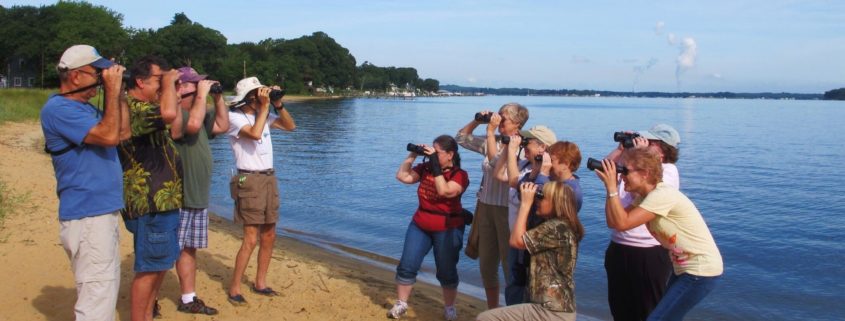
The most useful birdwatching binoculars incorporate a few basic features. They have a central focus wheel and a diopter focus adjustment. The diopter is often part of the right-hand eyepiece on a binocular. The diopter helps compensate for the differences between your two eyes. To get the clearest image from your binocular, you need to adjust both the diopter focus and the central focus.
Focusing:
- Start by adjusting the distance between the two barrels of the binocular so they are the right width apart for your eyes. If you see black edges in your field of view, the barrels are either too far apart or too narrow. If the spacing is correct, you should see a perfect circle.
- Once you see a perfect circle, find something to focus on that stands out against the background – a dark tree branch against a blue sky, an overhead wire, or a street sign. Turn the central focus wheel to focus with both eyes.
- To adjust the fine focusing, close your right eye, and only using your left eye, adjust the focus wheel. Then bring both eyes into focus by adjusting the diopter wheel.
- Open both eyes and see if your focus is completely clear. If the image is still slightly out of focus, repeat these steps, making small adjustments.
If the view through your binoculars appears almost three-dimensional, your focus is correct. Your eyes shouldn’t be straining when you’re using binoculars.
Finding the Bird:
This is one of the more challenging tasks and takes lots of practice. It’s best to find landmarks near the line of sight to the bird. This might be a particular branch arrangement in a tree. Or a post on the distance shore in a lake or boat on the horizon. Any thing will do as long as it distinctive. While staring at the bird raise your bins to your eyes. Try to find the landmark. Check that the landmark is in focus (assuming it’s nearly the same distance away). Now move towards where you think the bird is located. This may take several tries. Don’t spend too much time scanning back and forth, especially if the bird is perching in a tree. They move around and you’ll miss that while your scanning.
Cleaning Your Binoculars:
The outside of bins can be wiped with a damp cloth. But pay careful attention to the lens. Good binoculars have sophisticated lens coatings that must be treated carefully! A few tips below, or consult numerous online sites.
- Don’t’s:
- Use spit!
- Wipe with your shirt tail!
- Use window cleaning fluids!
- Do’s:
- Carefully brush debris from the lens, preferably with soft brush designed for lenses.
- Or blow with clean compressed air.
- Use lens cleaning solution designed for coated lenses applied to each lens.
- Carefully wipe with a very soft clean cotton or microfiber cloth.
- Hold the bins such that light reflects from the lens surface and check for smudges or wet spots.
- Repeat as needed.
Protecting Your Binoculars:
Binoculars depend on co-alignment of the optical train. Mess that up and you’ll get displaced images and likely get a headache! So best to not have them sliding around in the car trunk without a case or cushioning. And “waterproof” doesn’t mean leave them out in the rain! Likewise, beach sand is a no-no.
